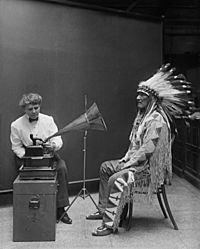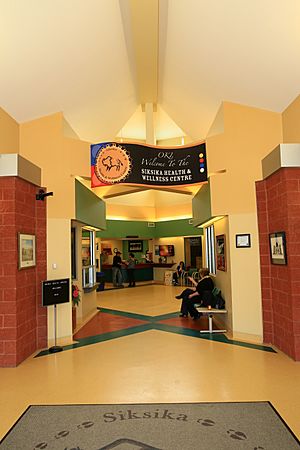Blackfoot language facts for kids
Quick facts for kids Siksika |
||||
|---|---|---|---|---|
| Siksiká (ᓱᖽᐧᖿ) | ||||

Frances Densmore at a recording session with Blackfoot chief Mountain Chief in 1916
|
||||
| Native to | Canada, United States | |||
| Region | Piikani Nation, Siksika Nation, and Kainai Nation in southern Alberta; Blackfeet Nation in Montana | |||
| Ethnicity | 51,221 Blackfoot | |||
| Native speakers | 4,915, 10% of ethnic population (2016) | |||
| Language family |
Algic
|
|||
| Writing system | Blackfoot Syllabics Sometimes Latin |
|||
|
||||
The Blackfoot language, also known as Siksiká, is an Algonquian language. It is spoken by the Blackfoot or Niitsitapi people. They live in the northwestern plains of North America. The name Blackfoot likely comes from the dark soles of the leather shoes the people wore.
There are four main ways Blackfoot is spoken, called dialects. Three are in Alberta, Canada: Siksiká, Kainai (Blood), and Aapátohsipikani (Northern Piegan). One dialect, Aamsskáápipikani (Southern Piegan), is spoken in northwestern Montana, United States.
Older speakers often use "Old Blackfoot," while younger speakers use "New Blackfoot." The language is unique among Algonquian languages in its sounds and words. Sadly, the number of people who speak Blackfoot has been going down. It is now considered a threatened or endangered language.
The Blackfoot language has lost many speakers since the 1960s. UNESCO calls it "severely endangered." In Canada, this loss happened because of residential schools. In these schools, Indigenous students were often punished for speaking their native languages. Also, during the "Sixties Scoop," many Indigenous children were taken from their families. They were placed with non-Indigenous families, which further led to language loss. Because of these challenges, the Blackfoot community is working hard to bring their language back.
Contents
What is the Blackfoot Language?
Different Names for Blackfoot
The Blackfoot language has a few different names.
- Pied-Noir is a French name for the Blackfoot tribe. It means "black foot."
- Other names for the language include Siksikáí’powahsin and Niitsipowahsin.
Where is Blackfoot Spoken?
Blackfoot is part of the Algonquian language family. It belongs to the Plains Algonquian group. Other languages in this group include Arapaho and Cheyenne. Blackfoot is spoken in Northwestern Montana and across Alberta, Canada. This makes it one of the westernmost Algonquian languages.
History of the Blackfoot People and Language
The Blackfoot people once lived on the Great Plains of North America. They were skilled bison hunters. They moved around the plains and into Canada, eventually settling in Montana. Blackfoot hunters would track game, while others gathered food for the harsh winters.
When European settlers arrived in the late 1700s, things changed. The settlers brought horses and new tools. But they also brought diseases like smallpox, which greatly reduced the Blackfoot population. In 1870, a peaceful Blackfoot tribe was attacked by mistake, and many people were killed.
Over the next 30 years, bison were almost completely wiped out from the Great Plains. This was a huge blow to the Blackfoot way of life. They could no longer support themselves and had to rely on government help.
In 1886, the Old Sun Residential School opened on the Blackfoot Reserve in Alberta. This school was not a good place for children. It was described as "unsanitary" and "unsuitable." It stayed open until 1971. The difficult experiences at the school, and the suppression of their language and culture, contributed to the decline in Blackfoot speakers.
How Blackfoot Words are Built
Blackfoot is a polysynthetic language. This means words are built by adding many small parts (morphemes) together. Each part usually has its own meaning. This makes Blackfoot words very complex.
For example, nouns and verbs cannot be used alone. They must have endings added to them. Because of this complex word structure, the order of words in a sentence can be quite flexible.
Nouns in Blackfoot
All nouns in Blackfoot are either "animate" (living) or "inanimate" (non-living). This is a grammatical rule, so some things that are not alive, like drums or knives, are still treated as "animate" in the language. Verbs also change to match if the noun they are talking about is animate or inanimate.
Nouns also show if they are singular (one) or plural (more than one). These endings are added to the noun.
Verbs in Blackfoot
Blackfoot verbs are very important. They can stand alone as a whole sentence. Verbs change based on who is doing the action and who the action is being done to. They also change based on whether the nouns involved are animate or inanimate.
A Blackfoot verb can have different parts:
- Preverbs are like prefixes. They can tell you about time, place, or how something is done.
- The root is the main part of the verb.
- Medials are suffixes that can add more details, like what kind of object is involved.
- Finals are suffixes that show if the verb is transitive (has an object) or intransitive (no object). They also show animacy.
The root and final parts are always needed for a verb.
How Blackfoot is Written
Latin-based Writing System
In 1975, the Blackfoot reserves in Canada adopted a standard way of writing Blackfoot using Latin letters. The Blackfoot alphabet has 13 letters: a, h, i, k, m, n, o, p, s, t, w, y, and a glottal stop (').
Some sounds are written with two letters, like "ts" and "ks". Vowels can have special marks to show pitch or length. Long vowels are written with a double letter, like "aa".
Syllabic Writing System
A special writing system called "syllabics" was created for Blackfoot around 1888 by John William Tims. This system uses symbols that represent syllables (like "ka," "ki," "ko"). It is similar to the Cree syllabics but has its own unique symbols.
This system was used for translating parts of the Bible into Blackfoot.
Blackfoot Literature
Many people have worked to translate important texts into Blackfoot.
- John Tims translated parts of the Bible in the late 1800s. He used both the Latin and syllabic scripts.
- Later, Donald G. Frantz and Patricia Frantz translated the Gospel of Mark in 1972.
- The Gospel of John was translated by Wycliffe Bible Translators and Blackfoot people in 1979.
Why Blackfoot is Endangered
One main reason Blackfoot is endangered is because of negative attitudes towards the language in the past. Children were often told not to speak their native language in schools. They were sometimes even punished for it. Teachers were sometimes ashamed if students spoke their native language. This made many children stop speaking Blackfoot.
Today, Blackfoot is considered "severely endangered." Most speakers are grandparents or older. There are fewer than 1,500 native speakers, and most are over 50 years old. If nothing changes, the language could disappear in the next 40 years as older speakers pass away.
However, there are good resources for learning Blackfoot. For example, the "Blackfoot Dictionary of Stems, Roots and Affixes" is a very detailed book. It helps people learn the language and understand its structure.
Efforts to Revitalize Blackfoot
Many Blackfoot communities are working hard to bring their language and traditions back to life. These efforts have been very successful.
The Piegan Institute
In 1987, Dorothy Still Smoking and Darrell Robes Kipp started the Piegan Institute in Montana. This group works to research, promote, and save Native American languages, especially Blackfoot.
In 1995, the Piegan Institute opened the Nizipuhwahsin School. This is a school where students from kindergarten to 8th grade learn completely in the Blackfoot language. Some of the first students from this school have even returned to teach the language to new generations.
Blackfeet Community College
Blackfeet Community College (BCC) opened in 1974. It is a college where teenagers and adults can take many different classes. They offer classes in Blackfoot language and traditions. They have beginner Blackfoot language classes for everyone, whether they are part of the community or not.
Chief Mountain Technologies
In 2009, the Blackfeet Tribal Business Council started a company called Chief Mountain Technologies. This company creates jobs for Blackfoot people in computer science and business. It helps tribal members use their culture and language in the modern world while keeping their traditions alive.
Radio Programming in Blackfoot
Radio station KBWG in Browning, Montana, has a one-hour show for Blackfoot language learners. It broadcasts four times a week. The station, called "Ksistsikam ayikinaan" (voice from nowhere), started in 2010. It plays music and has jokes that are unique to the Blackfoot community.
Canadian Government Support
The Canadian government has also provided money and resources to support Indigenous languages. They have funded digital libraries with interviews from native speakers and online courses. This helps promote Blackfoot and pass it on to future generations.
In 2019, the Canadian government invested over $1.5 million to support Indigenous languages in Southern Alberta. Many projects focus on Blackfoot, including language classes, workbooks, graphic novels, a video game, and a mobile app.
Alberta's government also helps through the Indigenous Languages in Education grant program. This program provides money for developing Blackfoot language training and resources for schools.
Piikani Traditional Knowledge Services
The Piikani Traditional Knowledge Services program works to protect and share the Piikani culture, language, and history. Their goal is to keep the Piikanissini way of life strong. This program offers cultural education, training, and resources to help keep the Blackfoot culture and language alive in the community.
Images for kids
-
Frances Densmore at a recording session with Blackfoot chief Mountain Chief in 1916
-
A sign at the Siksika Health and Wellness Centre in Siksika 146 reads "Oki", a Blackfoot greeting
See also
 In Spanish: Idioma siksiká para niños
In Spanish: Idioma siksiká para niños




